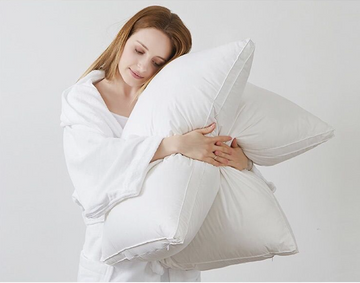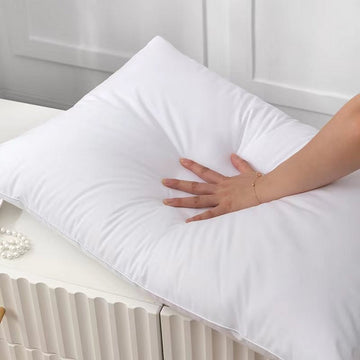Understanding the Basics: Down and Feather Fillings
What are Down Pillows?
Down pillows are filled with the undercoating of ducks or geese. This layer lies beneath the outer feathers. It's known for its loft and warmth. Down clusters trap air well, making the pillow soft. Such pillows are light and can last for years. They are often seen as a luxury bedding choice.
What are Feather Pillows?
Feather pillows are known for their support. They are filled with the feathers of ducks or geese. Unlike down, feather fillings have quills. These quills can sometimes poke through the cover. But, they do add to the pillow's firmness. This makes feather pillows less plush than down. They are often cheaper than down pillows. Feather pillows hold their shape longer. They are good for side and back sleepers. If you prefer a firmer pillow, consider a feather one.
Comparing Down and Feather Materials

Down and feather are both popular pillow fillings, but they have distinct properties. Down, taken from the undercoat of geese or ducks, is known for its exceptional softness and insulation capabilities. This fine, fluffy material traps air effectively, providing warmth without weight. Feather pillows, on the other hand, are filled with the outer feathers of birds. These feathers are larger and have quills, making them firmer. They don't trap air as well as down, hence they offer less insulation but more support. When comparing down vs feather, consider that down is often pricier, but it also tends to last longer due to its resilient clusters. In contrast, feather pillows may flatten out more quickly over time. Ultimately, the choice between the materials depends on personal preference for firmness, temperature regulation, and budget.
Health and Comfort Considerations
The Allergy Factor: Down vs Feather
When choosing a pillow, allergies matter. Both down and feather pillows can stir up allergies. Down is often treated to be hypoallergenic, making it friendlier for those with sensitivities. Feathers, however, can trap dust and allergens more easily. In this case, down may be the safer choice for allergy sufferers. Always check for certifications that confirm hypoallergenic treatments.
Support and Comfort: Which is Better for Sleep?
Choosing the right pillow is key for a good night's sleep. Down pillows are soft and plush, enveloping the head with a luxurious feel. They can adjust to your movements for continuous support. Feather pillows, on the other hand, are firmer. This gives your head and neck a steady platform. However, they might not offer the same snugness as down pillows. Both types have their perks, depending on your comfort preference. Side sleepers may prefer the firmness of feather pillows. Back or stomach sleepers might opt for the gentle embrace of down. The right choice varies with personal sleep style and comfort needs.
Temperature Regulation: Down and Feather Compared
- Down pillows offer superior insulation, retaining warmth effectively.
- Feather pillows are more breathable, providing a cooler sleeping surface.
- Down can lead to overheating in some sleepers, especially in warmer climates.
- Feather fill allows better air circulation, which helps to dissipate heat.
- A blend of down and feathers might offer a balanced temperature for some.
- Pillow covers also play a role in temperature regulation – natural fibers are best.
- Personal preference and sleeping environment should guide the choice for individual needs.
Care, Durability, and Value
Longevity: How Long Do They Last?
When investing in pillows, longevity is a key factor. Down pillows tend to outlast feather ones. On average, down pillows can last between 5 to 10 years. Feather pillows often have a shorter lifespan, usually around 3 to 5 years. The difference is due to the resilience of down clusters, which don't break as easily as feathers. Furthermore, down is less prone to flattening out over time compared to feathers. Therefore, down pillows maintain their shape and fluffiness longer, ensuring a prolonged comfort experience.
Maintenance: Caring for Your Pillows
To maintain your down or feather pillows, follow simple steps. Use pillow protectors and wash them regularly. Spot clean any spills right away. For washing, use a mild detergent and gentle cycle. Always dry thoroughly to prevent mildew. Fluff pillows daily to maintain shape. Rotate them to spread wear evenly. Avoid using harsh chemicals, as they can break down the fillings. By caring properly, you'll extend the life of your comfortable pillows.
Cost-Benefit Analysis: Down vs Feather
When weighing down versus feather pillows, the price plays a pivotal role. Down pillows tend to be more expensive due to their superior softness and insulating abilities. They are considered an investment, as they generally last longer than feather pillows. Feather pillows, however, offer a lower upfront cost. They may need replacing more often, affecting long-term value. It’s important to balance initial cost against lifespan and comfort to determine which pillow offers the best cost-benefit for your needs. Think about the long-term to make a wise choice.
Referencing articles to compare the differences between Down vs Feather Pillow.:Duck Down vs. Goose Down: Evaluating Your Best Bedding Options






